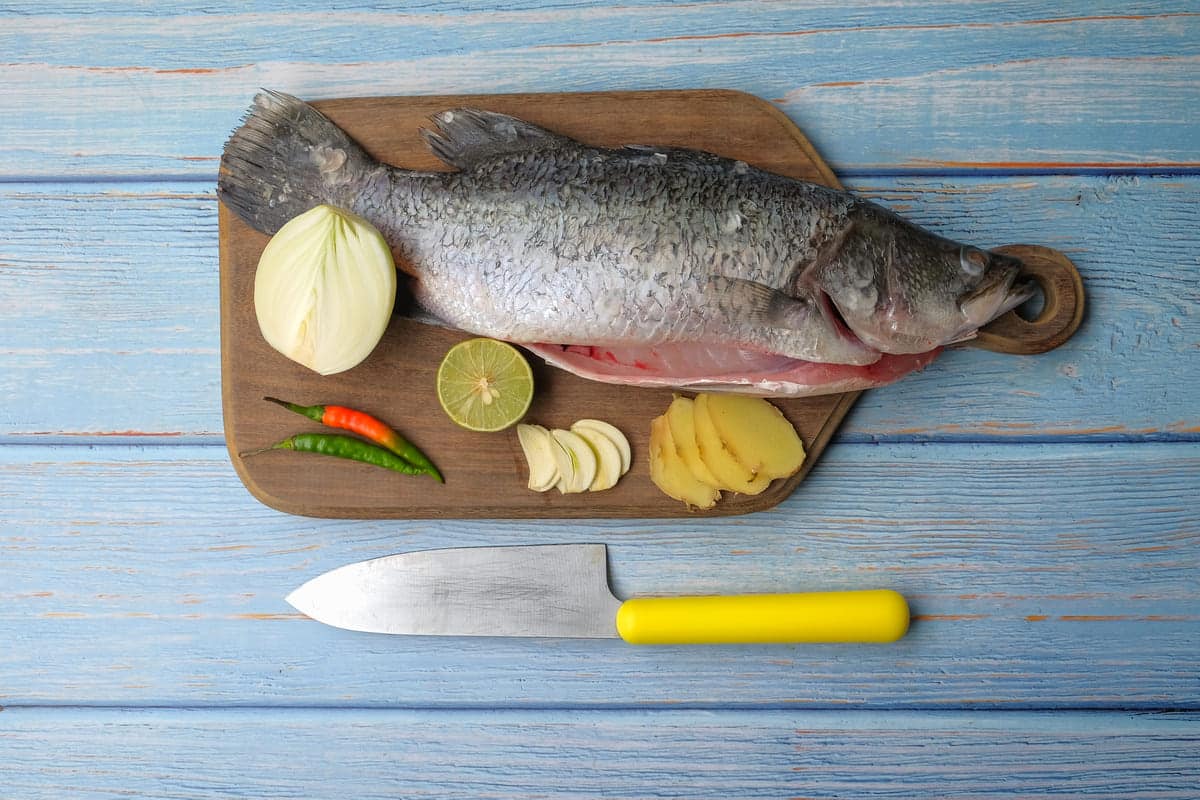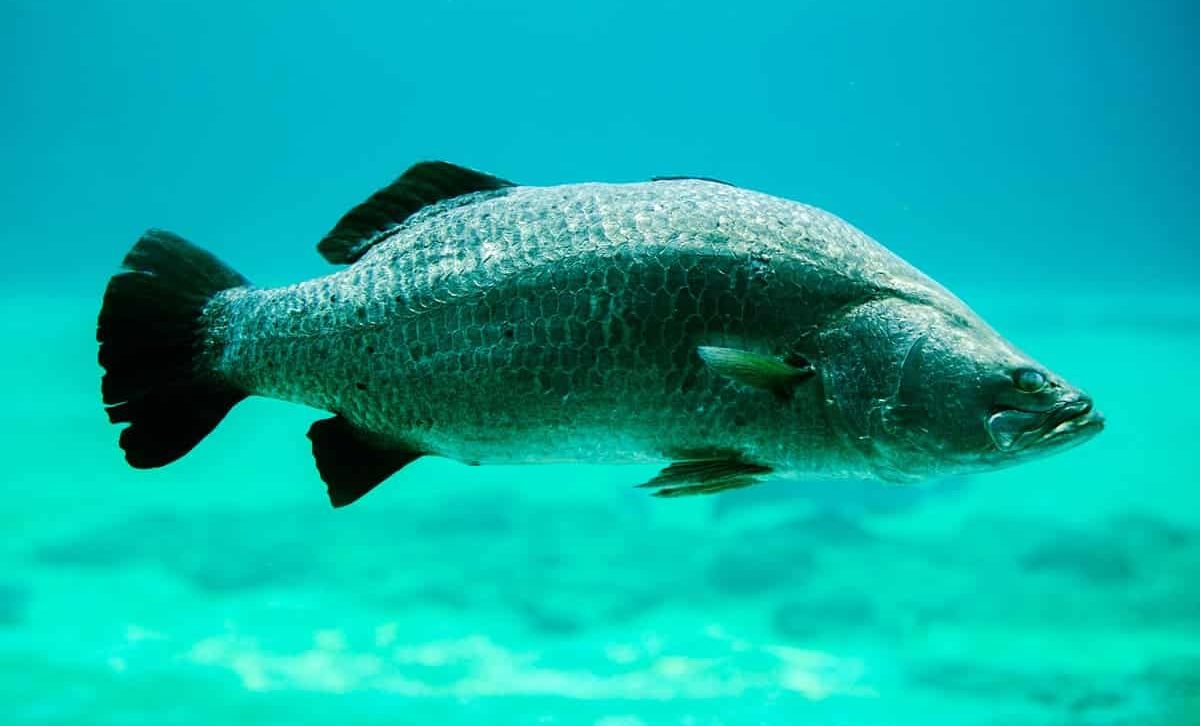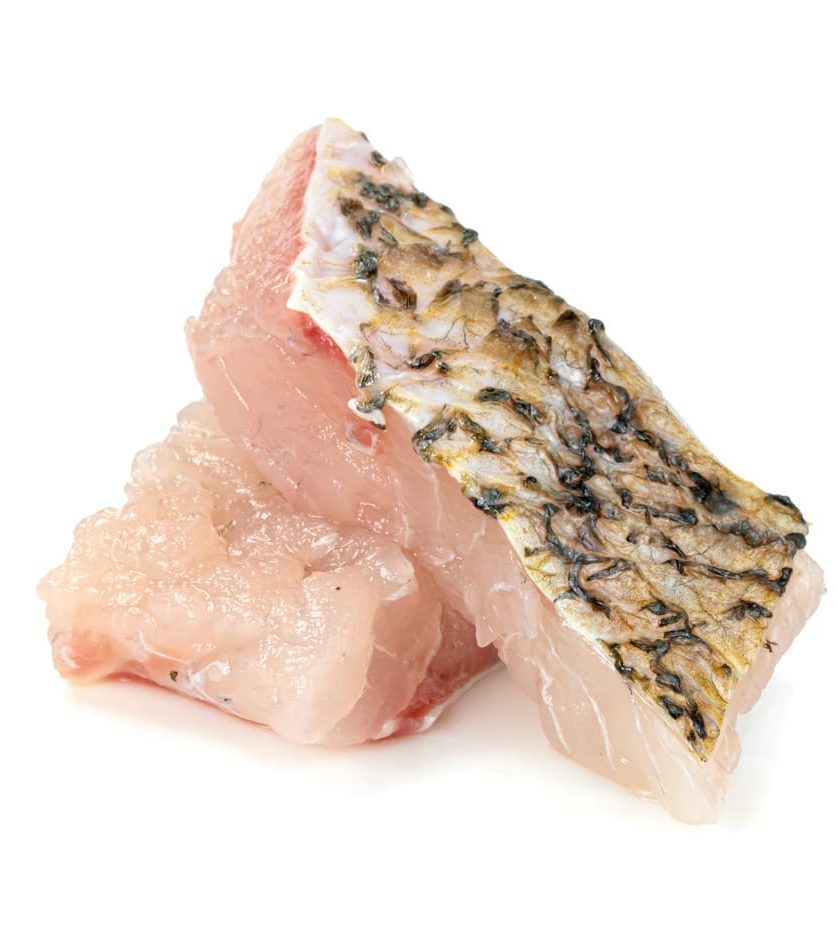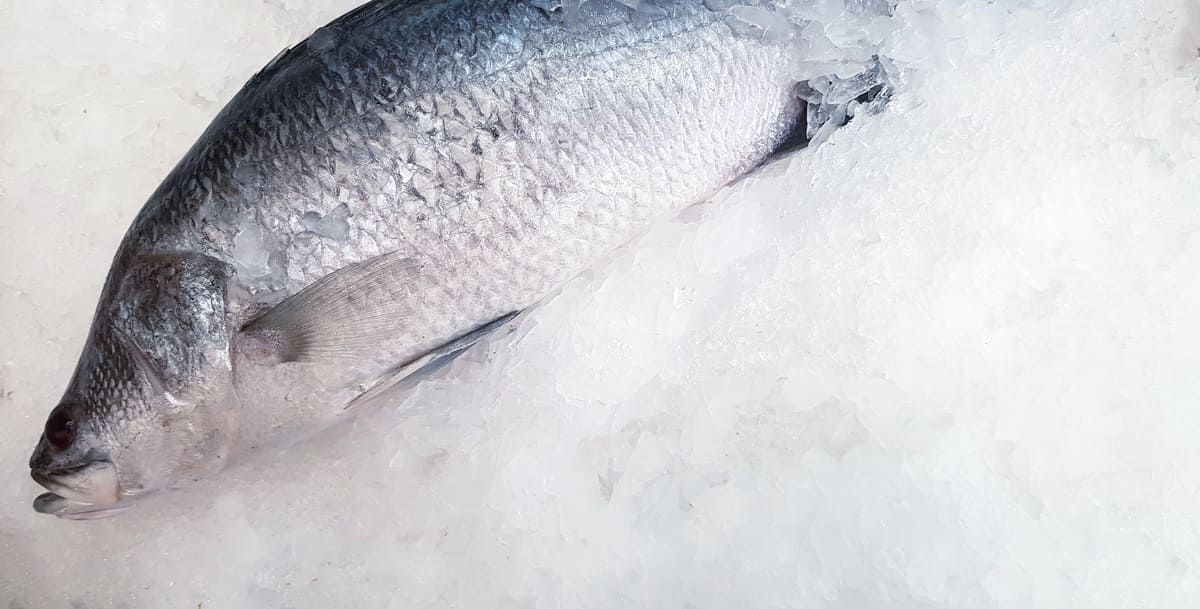
Introduction
The barramundi, a species of fish native to the Indo-Pacific, has long captivated the hearts and minds of fishermen and aquarists alike. The barramundi is an impressive sight with its silver scales and striking shape.
Native to tropical regions, this famous fish today has adapted to various habitats and can be found in saltwater and freshwater. Not only does it have a unique appearance, but it also has some fascinating behaviour, such as leaping out of the water or swimming up river estuaries. Its adaptability and beauty make it one of the most sought-after fishing and aquaculture species.
Description & Characteristics
Barramundi, or Lates calcarifer, is a fish native to the Indo-Pacific region. It is a prized gamefish and is highly sought after for its meaty texture and delicate flavour.
The barramundi has a long and slender body with an oblong head that tapers down to a point. Its dorsal fin runs along its back from the head to the tail and has two separate pectoral fins on either side of its body. These specially adapted fins enable them to move swiftly without expending much energy. This makes them well-suited for both still waters and swift currents alike.
Barramundi can reach up to 1 meter long when fully mature but are typically harvested at around 30 centimetres for commercial purposes due to their mild taste and flaky texture when cooked.
Biology
Barramundi, also known as Asian sea bass, is a hardy fish in the Indo-Pacific region belonging to the family Centropomidae. These fish are known for their ability to thrive in fresh and saltwater environments, making them a highly sought-after species for fisheries and fish farms.
A unique characteristic of this species is their ability to travel between different bodies of water during different phases of their life cycle; they will often migrate long distances from brackish estuaries to freshwater rivers during the spawning season.
Wild barramundi is typically found in shallow coastal waters such as estuaries, creeks, rivers, lagoons, and mangrove swamps. In contrast, farmed barramundi are generally raised in large ponds or tanks with specially formulated pellets for their growth and development. These conditions allow for rapid growth and production of high-quality fish compared to their wild counterparts.
Barramundi has been largely successful in aquaculture systems due to their wide adaptability across many habitats and rapid growth rates. As such, they are one of the most commonly farmed fish species worldwide; over 6 million tonnes of barramundi were produced through aquaculture in 2018 alone. This success has led to increased fishing pressures on wild populations, which has caused some concern among conservationists.

Habitat And Distribution
Barramundi is widely distributed across Southeast Asia and Australia’s tropical and subtropical waters. Its habitat ranges from the east coast of India, throughout Southeast Asia, to the north of Australia in the Northern Territory and Western Australia. It is commonly found in estuaries, rivers and streams with still or slow-moving water.
By living in such diverse habitats, barramundi can take advantage of various food sources, including small crustaceans, fish larvae, molluscs, insects and plant material. This broad diet enables them to remain healthy as they migrate between different areas throughout their lifetime.
Barramundi Fisheries
Barramundi is an important fish species for many commercial fisheries worldwide. This fish is highly sought after for its tasty flesh and relatively easy fishing process.
Fishing for barramundi is mainly done using trawling methods in shallow waters near shore. The trawling nets can be either bottom-trawling or mid-water trawling, producing higher yields due to the wider area covered.
Other fishing methods can also be used depending on location, including gillnets and trolling. In some parts of Australia, recreational barramundi fishing is popular as it can provide an exciting sportfishing experience with large catches possible.
The current level of harvesting of barramundi has led to concerns about the sustainability of this fishery, as overfishing could lead to a decline in stock numbers and population size overall. Sustainable practices must be implemented and monitored to ensure that the barramundi population remains healthy for future generations.
Sustainability
The sustainability of the barramundi fishery is an important consideration when evaluating the viability of its population. While the species currently has a healthy population, the fishing industry needs to take steps to ensure that this continues. Overfishing, destruction of habitat, and other human-caused environmental factors can lead to a decrease in barramundi numbers if not appropriately addressed.
Overfishing and habitat destruction must be prevented to promote sustainable fisheries. This includes establishing and enforcing catch limits, implementing closed seasons during which fishing is prohibited, and creating protected areas where fishing activities are limited or banned altogether.
Additionally, methods such as aquaculture can be used to supplement wild populations if done responsibly. Such practices would help reduce pressure on wild stocks while providing a reliable food source for local communities.
Furthermore, efforts should be made to reduce other human-caused impacts on barramundi habitats, such as pollution and sedimentation caused by development projects. Depending on their severity, these threats can directly or indirectly affect fish populations, with long-term consequences for local ecosystems if not addressed promptly.
By taking proactive measures to minimise these issues, barramundi fisheries can remain productive while contributing economically and culturally to their respective regions.
Life Cycle of Barramundi
Barramundi’s life cycle is interesting, as it adapts to its environment at different stages of its development.
Barramundi displays an interesting phenomenon called ‘protandry’; this means that they are male during the first year of their lives. By the end of their first year, they change their sex to become female.
This enables them to produce more eggs than other species when the spawning season arrives. They also possess an incredible ability to adapt to drastic changes in their environment, such as water flow rate or temperature changes. These remarkable adaptations have enabled them to survive over thousands of years.
The life cycle of Barramundi can be divided into three main stages: juvenile stage (0-2 years), adult stage (2-5 years) and mature stage (5-7 years).

During the juvenile stage, barramundi migrates downstream towards estuarine systems, feeding on small crustaceans while proliferating. As they reach the adult stage, they will move back upstream into freshwater rivers until the spawning season arrives.
During the mature stage, adults swim back into estuarine systems and spawn multiple times during the spring and summer months before returning upstream again.
As part of this life cycle, barramundi can also migrate long distances depending on salinity levels, allowing them to access many habitats for feeding and breeding purposes. This has enabled them to establish populations in many parts of South Asia and Northern Australia, making them one of the most populous river species in these regions.
Etymology
The etymology of the barramundi is steeped in history. Believed to have originated in northern Australia, its name is derived from the Aboriginal language. The word ‘barramundi’ is supposed to come from the Aboriginal words ‘barra’, meaning large and ‘mundi’, meaning fish. This captivating species has been a source of sustenance for generations of indigenous Australians and provides a much sought-after delicacy for fishermen globally.
Barramundi’s Diet
The diet of the Barramundi is primarily composed of white fish, crustaceans, and other tiny aquatic organisms. Young barramundis feed on insects, larvae, and plankton, while adults feed on larger prey such as small fish and crustaceans.
The Barramundi is also farmed in sea cages in areas such as the Persian Gulf and along coastal rivers and estuaries, where they are fed formulated pellets. These wild-caught fish have been found to feed more heavily on benthic organisms than pellet-fed farmed fish.
Barramundi As Food
Barramundi is a popular seafood choice in maritime Asia and has recently seen a surge in popularity in other parts of the world. The barramundi taste has a mild flavour and firm texture and can be prepared in various ways.
Barramundi offers many benefits, including:
- High nutritional content: Barramundi is an excellent source of protein and contains high levels of vitamins A and B12, calcium, phosphorus, omega-3 fatty acids, and iron.
- Versatility: Barramundi can be enjoyed fried, grilled, steamed or baked with various herbs and spices. It is often served with vegetables for a complete meal.
- Price: Barramundi is relatively inexpensive compared to other fish varieties.
- Sustainability: Due to its rapid growth rate and ability to withstand overcrowding in aquaculture systems, barramundi can be raised sustainably without causing harm to the environment.
Garlic butter sauce and cilantro pesto pair well with the barramundi’s mild flavour. The firm flesh holds up well during cooking, so it’s suitable for grilling or baking at high temperatures.
When preparing barramundi at home, it’s best to use fresh ingredients such as herbs and spices. Additionally, due to its low-fat content, the fish should be cooked on low heat for shorter periods, or it will dry out.
To bring out the best flavours in barramundi while still keeping it moist, try grilling it on medium heat with a light coat of oil or butter; this will help prevent sticking while still providing enough flavour to please any palate.

How To Prepare Barramundi
Barramundi, a favourite of many seafood lovers, can be prepared in various ways. From grilling to baking to steaming, the options for cooking this delicious fish are seemingly endless. But what is the most effective way to ensure this flaky white fish turns out juicy and flavorful?
Grilling is an excellent method for cooking barramundi. It is easy and fast and allows for even cooking and caramelisation of the fish’s natural oils. Begin by preparing the barramundi by cleaning and scaling it before seasoning it with salt, pepper, or other desired spices. Once seasoned, oil the grate on a hot grill before placing the barramundi on top. Grill for 10-12 minutes per side until it is cooked; gently flip each side. Consider basting it with melted butter or olive oil while it cooks for added buttery flavour.
Baking is another great way to cook barramundi in the oven. Start by preheating your oven to 400 degrees Fahrenheit before brushing both sides of your filet with oil or butter. You can place it in a greased baking dish and season it as desired before covering it with foil or parchment paper. Bake for 15-20 minutes, depending on thickness until cooked through and flaky. To further enhance its flavour, consider adding aromatics like herbs or citrus slices during baking time.
Best Side Dishes Paired With Barramundi
Barramundi’s mild flavour, firm texture and high oil content make it a popular choice among chefs and home cooks.
When planning a meal featuring barramundi, several side dishes pair well with this delicious fish:
- Grilled vegetables: Whether grilled on their own or as part of a vegetable medley, vegetables such as zucchini, carrots, mushrooms, and bell peppers bring out the subtle flavours of barramundi while adding colour to any dish.
- Potatoes: Roasted potatoes, mashed potatoes, or french fries are all great options for pairing with barramundi. The starchiness helps cut through the fish’s richness while complementing its flavour.
- Salads: A light salad with seasonal fruits or greens pairs nicely with barramundi. Often salads provide a nice contrast in texture from the firm fish.
- Rice: White rice or brown rice can be served as an accompaniment to barramundi for a complete meal. The neutral flavour allows the dish’s seasonings and other components to stand out more prominently.
The key to creating perfect pairings for barramundi is finding complementary ingredients that highlight its natural flavour without overpowering it. With careful consideration of flavours and textures, you can create unique dishes that your family and friends will love. Whether you opt for traditional recipes or something more adventurous, you’re sure to have a delicious meal when serving up some barramundi!
Popular Barramundi Recipes
A popular recipe for barramundi is pan-fried with olive oil and garlic. This simple yet flavorful preparation involves marinating the good-sized whole fillets in olive oil and garlic before coating them lightly with breadcrumbs or flour, then frying them until golden brown and cooked. Using a paper towel, strain out any excess oil. The result is a flaky fish that pairs well with vegetables or potatoes.
Cooking barramundi does not have to be complicated; the fish tastes excellent when seared on each side until cooked through, then served with freshly squeezed lemon juice and dill-infused sour cream — an ideal combination for those who prefer their food light but flavorful.
With barramundi as the star ingredient, there are endless ways to prepare delicious dishes – from soups to curries to salads – so no matter what you’re looking for, there will be something delicious.
Comparison To Other Fish
Barramundi is often compared to other fish, such as snapper, mackerel, and salmon. With its firm white flesh and mild flavour, barramundi is prized among chefs for its versatility in the kitchen. Its skin can be fried or grilled, while its flesh can be poached, steamed, baked or smoked.
Compared to other fish, barramundi has a higher fat content than most. It contains more omega-3 fatty acids than salmon and mackerel, making it a healthier choice for consumers looking for an alternative source of protein.
Health Benefits of Barramundi
Barramundi contains high Omega-3 fatty acids, essential for proper body and brain function. Studies have found that consuming Omega-3 fatty acids can reduce inflammation throughout the body and help protect against heart disease and stroke.
Additionally, barramundi is a good source of protein and low in saturated fat. It is also rich in vitamins A, B6, and B12 and minerals like iron, zinc, magnesium, and phosphorus.
Conclusion
In summary, barramundi has become increasingly popular through recreational fishing and aquaculture due to their willingness to take the bait and give an intense fight when hooked, as well as their health benefits, such as high omega-3 fatty acid content and low mercury levels compared to other large predatory fish. With its mild flavour and versatility in cooking styles, barramundi has become an invaluable asset for many seafood lovers worldwide.
